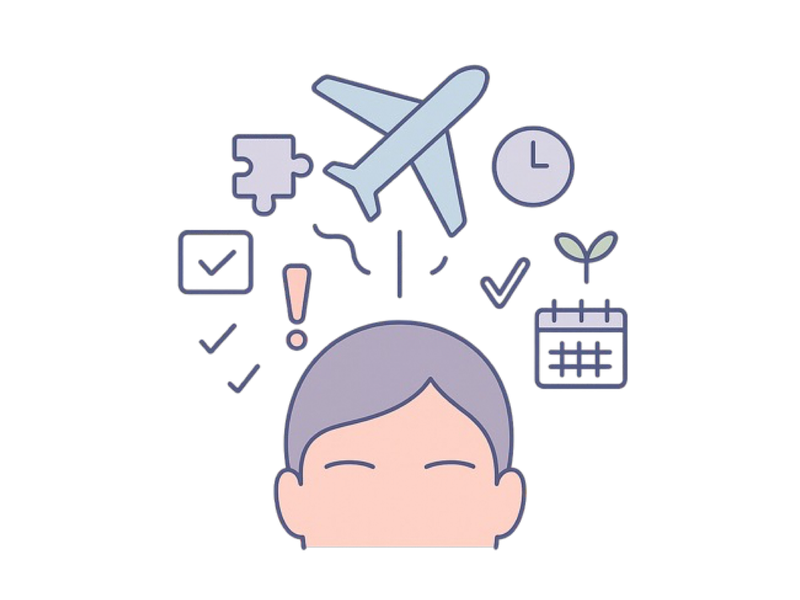Designing for Presence in Productivity

We design and build apps to help businesses be more productive so naturally I think a lot about productivity. And if I were to shadow myself for a day, I’d notice parts of my schedule that don’t feel like the most productive use of time. At least not compared to what I imagine I could achieve.
However, while in industry, productivity is defined in terms of the rate of output per unit of input, different people optimise for different things. But productivity isn’t one thing. It’s many things: efficiency, focus, responsiveness, creativity, momentum. The catch is, you can’t maximise them all at once. Designing a productivity system is about choosing which one you’re optimising for, and accepting the trade-offs that come with it.
My days don’t always feel productive. In the moment, I often wish I was accomplishing more. But that’s the paradox of what I've chosen to do. By leaving space unplanned, I create the capacity to be present for the conversations and decisions that matter most to me. It only looks unproductive if I forget that presence is what I’m optimising for.
Presence as a form of productivity
For me, productivity isn’t about maximising every hour of my day. It’s about being fully present when it matters, in early intent-setting conversations, for in-person relationships, in the moments where decisions get made and direction gets set.
To make that possible, I keep unallocated periods in my schedule. That space is what allows me to be present. It also means I can be responsive to a few things that pop up, without losing momentum. But it comes at a cost: many days I don’t feel like I’m using the maximum of my energy and time, because some of that space simply goes unused.
Presence as a form of productivity
I don’t have a set working routine. I don’t devote large blocks of time every day to projects. Instead, I keep flexibility so I can show up when it counts. A few weeks ago, when a key contact wanted to discuss a project, I flew to meet them rather than taking an online call. That choice took more time, but it made me more productive because I was fully present at the moment when intent and trust were being shaped.
Presence matters because early conversations tend to expand and I find that if you’re not there, the direction can drift, and the cost of that drift multiplies over time, as per the Room Where it Happens by Hamilton.
Being productive when you’re constantly context switching
As a leader of a software agency, there’s a part of my job that requires responsiveness to the businesses we work with. Taking days to come back to a basic query can be frustrating for a client. But it wouldn’t be reasonable to expect our developers to operate that way — their productivity depends on focus.
I’ve designed my role so the team can focus on designing and building software, while I cover a wide range of operational tasks. Yesterday I did some (rare) programming on an app prototype, paid some bills, and tidied up a presentation for a talk. Those tasks are worlds apart, and switching between them is hard.
That’s why presence is so important: when I do switch, I want to give full attention to the task or the person in front of me, not spread myself thin.
I suspect many leaders of midsized businesses will find this situation familiar. When you're switching between lots of different jobs, it helps to have tactics to overcome the inertia of getting started on another type of project. These are a few productivity techniques I use.
And this is where the bigger point comes in: every productivity system is a design decision. You might design yours around deep focus, or around creative exploration, or around responsiveness. But you can’t design for all of them at once. Something always gives way.
Warming up my mind
I find productivity a bit like going out on my bike when it's cold. You resist it for the first five minutes, but as soon as your body warms up, you stop thinking about it.
AI can help me overcome the initial friction of starting a new task. If I'm not in the mood to structure my thoughts, I use AI like a journal, where I jot down my thoughts and it reflects them back. Sometimes those reflections don’t go anywhere. That’s fine. I'm not hoping AI will solve my problem. It’s about getting my thoughts out of my head, engaging my brain in the topic and giving me some perspective. AI helps me transition into the work.
AI also gives me permission to write my thoughts as they arrive. If I open a new document, I start thinking too hard about writing and the structure. I’ll care too much about sentence structure and how I phrase ideas. AI tools allow me to mistype words and get my ideas out anyhow because they summarise and order content so well.
Telling myself I’m going to enjoy the work
If it’s horrible weather when I plan to go riding, I don't want to go. But if I picture myself going down the track, having a good time, I can push through.
The intellectual version of that is when I'm about to work on something hard and I don't want to get started. I tell myself I'm going to really enjoy the task. And I remind myself that often when I get immersed in a project, I get into flow and it's hard for me to stop.
Allowing space for ideas to develop
Incubation is an important part of productivity. Once I have all the pieces of a puzzle in my head, I allow myself to spend time with that info, trusting myself that when I need to come up with solutions it will happen.
Our book on balance came out of a period of working with ideas. I was sitting on a plane reading through a series of articles we’d written on Smudge’s approach and there was a moment where I saw the structure for the book click into place. That realisation wouldn’t have happened without all the months of work developing those ideas.
Capturing ideas when they appear
Sometimes I’m at my most productive when I respond to an inspiring insight in the moment. But often it's not practical to do that, so I’ve got good at capturing the energy of a new idea when I feel it. Taking notes has become my default.
The trade-offs of presence
I’ve a friend who’s a pilot. It could be easy to look at his life and think, this guy is so lucky to get to go to a wide range of cities around the world every two weeks with plenty of free time for exploration. And he does, and he enjoys it, but he pays a price for that in other areas of his life we don’t necessarily consider.
Or you might look at my life and see what I feel are exciting projects and the travel. Those things are real and as a business owner, I also have to work on balancing our workload and capacity and make sure we do the things we need to do to be profitable. That comes at a cost. Running a business, parenting two toddlers, and trying to fit in exercise during daylight hours often means working at nights and weekends.
It also takes effort to keep my schedule fairly-responsive and presence based. If an organisation we work with in Australia or the US says: “Can you make it for a project kick off next week?” I can often make that happen because my life's organised that way. However, I live in a mental space where I'm ready to go constantly, leaving my young family and my wife.
I don’t say this to draw attention to myself. I’ve made intentional choices about how I want to be productive, I live with those choices, and I’m happy with the cost of them (most of the time). I also don’t recommend my priorities as the right priorities.
What I can do is look at the form of productivity I’ve optimised for and see what works for me — and still wish it could be better, that I could do more. But I also know I can’t have it all. Every system of productivity gives you some things at the expense of others.
For me, the form of productivity I’ve optimised for is presence — with enough responsiveness built in to keep momentum. It works because it allows me to show up fully, both for others and for myself. But it comes at the expense of personal output maximisation.
Every productivity system is a design decision. You can design for deep focus, for creative exploration, for efficiency, for responsiveness, or for presence. But you can’t design for all of them at once. Something always gives way.
So my question is: what form of productivity are you optimising for? Have you designed your time around it — or are you still hoping you can be equally productive in every dimension?
